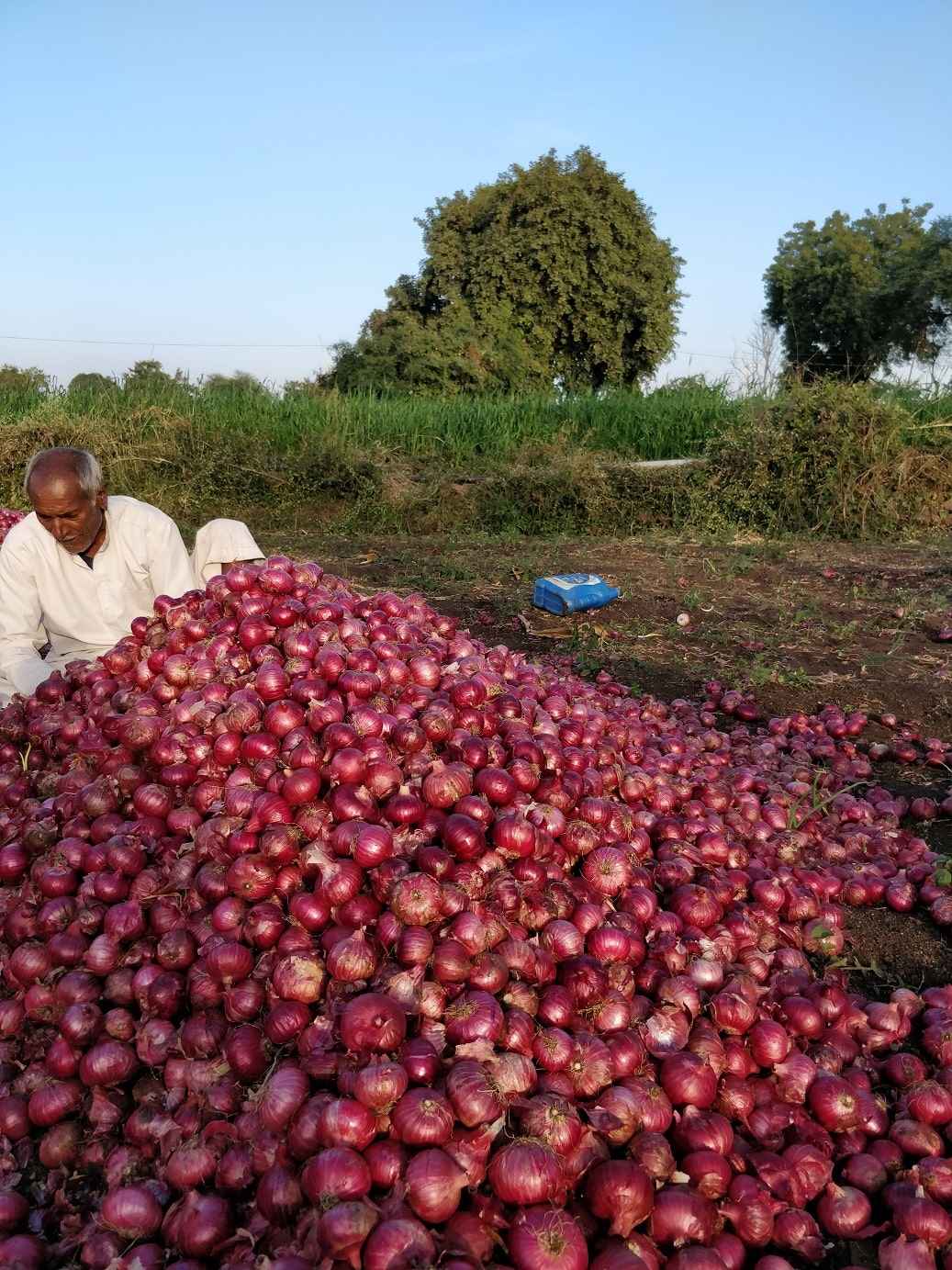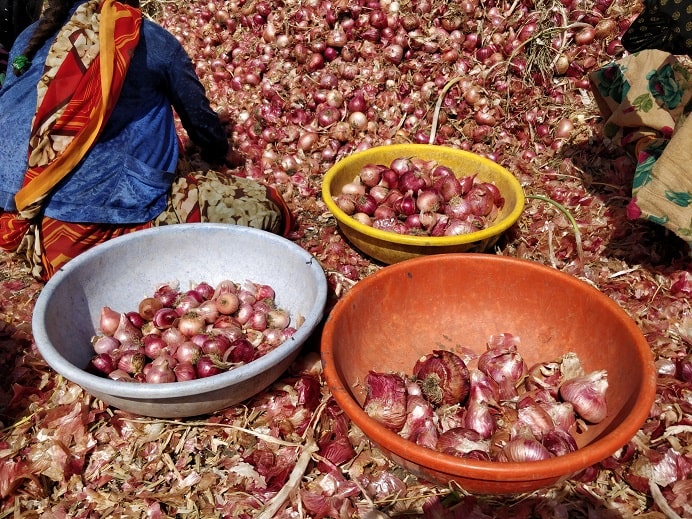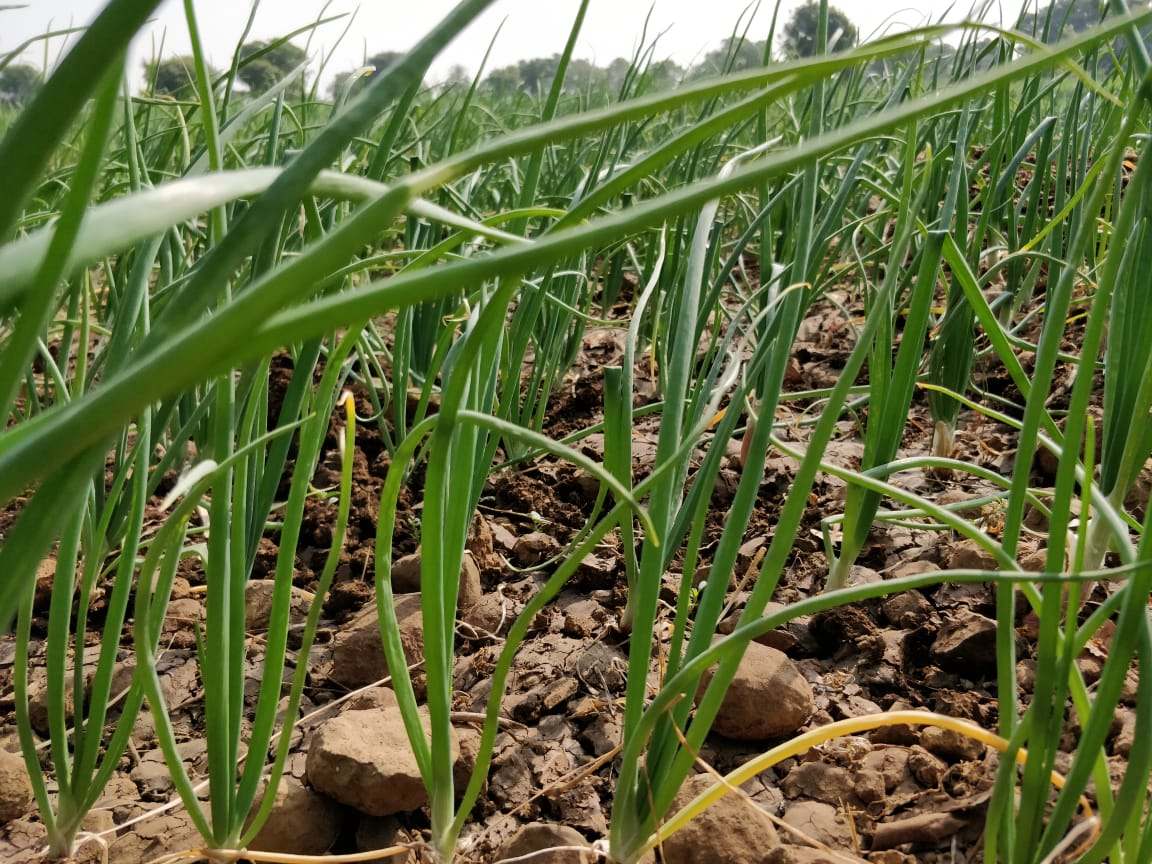The allure of the onion
Fieldwork can produce odd obsessions. As an anthropologist studying agrarian risk economies, mine was onions. In the central Indian region of Malwa where I conducted research, onions seemed to be everywhere. As I observed (and occasionally, but poorly, assisted with) farm work, I became fascinated by the bulb: its seasonal shades of pink shifting from winter magenta to a spring blush; the way its bright green stalks stood perfectly upright in the field; the speculative frenzy of the auction during peak season; its pungent flavor in raw, pickled, or fried form; and not least, the unexpected wealth it produced for a few and the dashed hopes and devastation it wreaked on most others.
For agriculturalists, the allure of the onion emanates from the material abundance it promises – both horticulturally and monetarily. Onion harvests can be bountiful, with yields as high as 250 quintals per hectare. The seasonality of crop cycles creates a small window of opportunity when old supplies dwindle and the new crop is yet to be harvested. Those who still possess onions in storage stand to make windfall gains during this brief period. Ultimately though, it is primarily dominant castes and classes of farmers who plant and profit from the pink bulb.

An elderly farmer man sits behind a large pile of red onions in a field (Author 2018)
Racial agrarian ecologies
In an agrarian landscape ridden with intersecting crises – social, ecological, and financial – the onion serves as an idiom through which rural frustrations and aspirations, as well as structural caste inequalities, are articulated. Peeling the layers of kanda, as the bulb is known locally, reveals the ways in which the work of cultivation not only produces commodity crops but reproduces racialized agrarian ecologies through ideologies and practices of caste.
Building on the premise that “ecological issues are inseparable from the articulation and perpetuation of difference” (Nishime and Williams 2018: 7), I consider how discourses and practices of cultivation naturalize hierarchical caste formations and essentialize the qualities of caste subjects. This framework of racial capitalism allows us to see “the manner in which people are constituted as different kinds of participants in capitalist formations” (Bhattacharya 2018: 50). While caste is certainly not identical to race, both entail a process of racialization “whereby humans are grouped (and self-grouped) according to assigned qualities that are assumed to be biologically innate, but that are in fact deeply shaped by the unequal distribution of power, resources, and knowledge” (Ranganathan 2022: 260). Analyzing the political ecology of crops, I argue, offers insights into the perpetuation of difference and inequality in agrarian landscapes, spaces that are rooted in the legacies of colonialism, enslavement, and caste oppression (Rogaly 2021).
While the onion is not ecologically unique or historically exceptional, it is a culturally and gastronomically significant plant. On the one hand, the onion is ubiquitous and foundational within the Indian diet. Even for the poorest households, it provides some flavor to otherwise sparse meals of roti (bread) and salt. On the other hand, as a root vegetable whose pungent smell and taste allegedly stimulated the passions, the onion has been the subject of (unevenly practiced) caste proscriptions. Its consumption is frowned upon among Brahmins and other upper castes, and to be entirely avoided during holy months. As a vegetable, onions are both the staple of the oppressed castes and working class and a taboo among dominant caste Hindus.
Its conditions of production are similarly distinct. Compared to the staple crops of soybean, wheat, and gram, the onion is a demanding crop. Its cultivation is capital-, labor- and water-intensive. It must be sown, transplanted, weeded, irrigated, sprayed, harvested, cured, stored, and sorted. In other words, its properties call for daily upkeep and vigilant care, both in the field and the home. The fluctuations in its price guarantees little by way of security. Cultivating onions is not for the faint of heart.
You are what you grow
The decision to sow onions (or not) is a complex one, shaped by the availability of capital and labor, access to water, the vagaries of the weather, and expectations of price. But these choices are more than economic or ecological. They are also moral and ethical. As performative spaces, the state of one’s farm and the quality of one’s crops are central to judgements of the character of the cultivator (Flachs 2019). The crops one cultivates are read as an index of one’s moral, social and economic status: you are what you grow. Plants produce persons even as only certain people can produce particular kinds of plants.
In the case of the onion, it was only the Patidar farmer, I was repeatedly told, who possessed the combination of discipline and daring essential to cultivation. The crop has come to be most closely associated with Patidars (or Patels), a dominant agricultural caste in west-central India. Regarded as Malwa’s agricultural pioneers, first settling the land and initiating commercial cultivation, the historical origins of Patidar as an endogamous caste formation can be traced back to agrarian capitalism in colonial India. They pride themselves on their agricultural expertise and entrepreneurialism, with many in the community successfully deploying agrarian surplus to diversify into allied occupations and trades. Indeed, I was instructed – by farmers, traders, and others – to study a Patidar village where I could really learn about agriculture in general and onions in particular.
So how does a crop become tied to a caste? And what does this entwinement reveal about regimes of “agricultural racial capitalism” (Manjapra 2018)?

Women agricultural workers sort onions into brightly colored tubs (Author 2019)
Cultivating caste
As a system of labor exploitation and segregation, caste is produced and performed relationally between hierarchically ordered groups. The agrarian identity of Patidar farmers is articulated through differentiation, particularly vis-a-vis Dalit (non-caste or ‘untouchable’) communities. Often, this was expressed in terms of crops. In the winter, for instance, local discourse centers on a comparison between wheat and onion – the former a staple food grain with a fixed market price, the latter also a kitchen staple but price volatile cash crop. Beyond the dictates of the market, however, this juxtaposition is grounded in caste supremacist moral and political ecologies that contrast the lazy and unambitious Dalit wheat grower with the industrious and resolute Patidar cultivator of onions.
This language of productivism and prowess is infused by caste ideologies, deployed to castigate Dalit farmers in particular as indolent and ineffectual agriculturalists (and men). While – as a Patidar man complained – “even they grow onions now”, Dalit cultivators are chastised and ridiculed for doing so. They just can’t do it properly. They have no interest in it. It’s just not in them. They only want to show off. But look at their fields, overrun by weeds and pests. Meanwhile, he (the male farmer) is off playing cards and getting drunk with his friends. As such, this vocabulary replicates familiar racialized colonial tropes of the “lazy native”, projected onto caste hierarchies and inflected with the capitalist ethic of productivity. Together, they evince an abhorrence for subsistence agriculture (exemplified by wheat) and a reverence for caste purity (revealed by the equation of vegetarianism and teetotalism with moral values).
Onions become a code for a caste-based agrarian capitalist attunement. Those who did not or could not properly cultivate onions were not adequately oriented to the rhythms of capitalist time-discipline and to the moral logics of embodied caste purity. So strong is the entwinement of caste and capitalism that a wholesale trader once declared that Patidar was now akin to a “brand name” in market transactions.
These purported connections between crops and cultivators subtly reproduces and naturalizes the violence of caste. The socio-material qualities of plants and their production is conflated with the moral qualities and economic potentialities of producers in a way that renders difference and inequality to be innate and inevitable.
Who does the work? Who owns the shops? Who eats the onions?
This framework intentionally obscures the expertise of agricultural workers whose labor is vital to onion production. The common sight of truckloads of workers being taken to Patidar farms during harvest testifies to this. The labor intensity of cultivation is double-edged. On the one hand, the manual labor of transplanting, weeding, and harvesting onions means that laborers – primarily Dalit women – have access to plentiful wage work throughout the season. On the other hand, this gendered labor is painstaking, arduous, poorly paid, and highly exploitative.
Even as profitable production is attributed to Patidar exertion and skill, this narrative occludes the networks of market-based knowledge on which successful cultivation and trade is based. Information about inputs and prices circulate through caste and kin networks, favoring upper-caste farmers whose caste fellows dominate agri-input retail shops and agri-commodity trading centers across the market towns of Malwa. In the words of a Dalit farmer, “They run all the shops. Do you think they will ever tell us how to grow our crops?”
If the onion is a symbol of (tenuous) upward mobility, caste regimes of labor and knowledge serve to thwart prospects of Dalit prosperity through the land. The failure to cultivate certain crops is ascribed to intrinsic deficiencies and individual weakness, rather than caste-based segregation and exploitation. Dalit agriculturalists are relegated to and essentialized as undisciplined and immoral laboring bodies, rather than autonomous and skilled tillers of the soil. Caste reveals itself as an unfolding “ecology of violence that debases and devalues humanity” (Vaughn et al. 2021: 280).
These uneven geographies of development extend to the realm of consumption. Traders note that the best onions – round, large, bright pink – go to urban centers such as Delhi while the poorest quality produce – onions that are small, dull, and even rotting – is sent to markets in underdeveloped regions of northern and eastern India. As a trader put it, ‘Halka maal for halka log’ (weak produce for weak people), referring to the supposedly malnourished and impoverished people in these places. Even more broadly, the market for these low quality bulbs is assumed to be meat-eaters and alcohol-drinkers (khane peene wale), again code for oppressed caste and non-Hindu communities. In a curious and cruel irony, the purity and piety of those who produce (and profit from) onions is counterposed with the impurity and impiety of those who consume them.

Bright green onions stalks sprout from the rocky soil (Author 2019)
Toward anti-caste agrarian ecologies
Examining how caste comes to be inscribed onto crops unearths some of the ways in which structural oppression is reconfigured as natural and immutable difference. As people shape agrarian environments, and vice-versa, ecologies and hierarchies are formed and transformed. Against this backdrop, how might we reimagine just regimes of production built through the redistribution of land and the liberation from caste? Can we generate relations between crops and cultivators that center nutrition and nurture rather than yield? Disentangling this discursive and material entanglement of plants, people, and landscapes is perhaps one step toward sowing and harvesting anti-caste and abolitionist agrarian ecologies.
References
Bhattacharyya, G. 2018. Rethinking Racial Capitalism: Questions of Reproduction and Survival. London: Rowman and Littlefield.
Flachs, A. 2019. “Planting and Performing: Anxiety, Aspiration, and “Scripts” in Telangana Cotton Farming,” American Anthropologist 121 (1): 48–61.
Manjapara, K. 2018. “Plantation dispossessions: the global travel of agricultural racial capitalism”. In: Beckert, S. and Desan, C. (Eds.), American Capitalism: New Histories. New York: Columbia University Press.
Nishime, L. and K.D.H. Williams (eds.) 2018. Racial Ecologies. Seattle: University of Washington Press.
Ranganathan, M. 2022. “Caste, Racialization, and the Making of Environmental Unfreedoms in Urban India,” Ethnic and Racial Studies 45 (2): 257-277.
Rogaly, B. 2021. “Commentary: Agricultural racial capitalism and rural migrant workers”, Journal of Rural Studies 88: 527-531.
Vaughn, S. Guarasci, B., and Moore, A. 2021. “Intersectional Ecologies: Reimagining Anthropology and Environment,” Annual Review of Anthropology 50: 275-290.

1 Comment
Dear Dr. Tanya,
Thanks for such a wonderful piece of writing. I was researching on caste and seeds from a posthuman lens and came across your interesting and relevant work.
Best Wishes,
Sunil